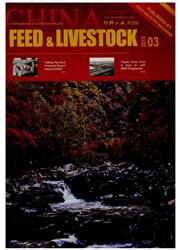

 中文摘要:
中文摘要:
采用4只体重(30±3)kg的山羊,运用^15N稳定性同位素示踪技术,按4×4拉丁方设计,研究了8.5%(A)、11.0%(B)、13.5%(C)和16.0%(D)4种蛋白水平日粮对山羊氮代谢的影响。结果表明:①日粮蛋白水平对氮的表观消化率影响较小,各组差异不显著,但随氮食入量的增加呈升高的趋势;②山羊体内氮沉积量显著或极显著受日粮粗蛋白水平影响,并且蛋白水平为11.0%时,获得最大氮沉积0.36g/W^0.75;③粪中^15N丰度和富集量都随日粮蛋白水平的升高呈现出先上升而后下降的趋势,其中B组最高,显著高于D组,A、B、C三组差异不显著;尿中^15N丰度和富集量都呈现出随日粮蛋白水平升高而升高的趋势,其中D组极显著高于A、B、C三组。
 英文摘要:
英文摘要:
For this research, four goats fitted with jugular fistulae were used as experimental animals, a 4×4 latin square experiment was carried out to study the effect of ration protein levels on metabolism of nitrogen in goat. Four different ration protein levels were 8.5% (A), 11.0% (B), 13.5% (C)and 16.0% (D), respectively. The results showed that: the apparent digestibilities of nitrogen raised with increases of ration protein levels, but there was no significant difference among four groups (P〉0.05). The retained nitrogen(RN) in B group was much higher than that in A group(P〈0.01) or in C and D group(P〈0.05). The highest retained nitrogen was observed as 0.36 g/d ·W^0.75 at treatment of 11.0% dietary protein.The abundance and enrichment of feces-^15N elevated at first then descended along with the increment of ration protein levels, group B was higher than that in group D(P〈0.01), but there was no significant difference between group A, B and C respectively(P〉0.05). The abundance and enrichment of urine-^15N showed a similar rising trend along with the accretion of ration protein levels towards different treatments, whereas group D got the highest among them.
 同期刊论文项目
同期刊论文项目
 同项目期刊论文
同项目期刊论文
 期刊信息
期刊信息
